|
Aren’t the three sports and varying distances that make up triathlon enough? For most of us mere mortals, yes. But an intrepid few scream into the void: “is that all you’ve got?!” and seek out challenges beyond the norm. (Disclaimer: I’m not sure if they actually screamed, or faced any sort of void - just my artistic interpretation.) Some particularly interesting events on this year’s team race calendar piqued my curiosity and left me needing to know more. Join me on a deep dive into these unique multisport challenges and the stories of our kick-butt teammates who have completed them.  Sea to Summit featuring teammate Carole Harbison What it is: a self supported 1.5 mile tidal river swim, ~92 mile point to point bike ride with 5000 ft of climbing (2000 net gain), and a 5.5 mile run/hike up Tuckerman Ravine (4400 ft climbing) to the summit of Mt Washington, the highest point in the NE. Okay wow. What made you sign up for this? Carole says “I wanted an unusual challenge this year, something different than the matchy matchy spandex/bright lights glamour of the IM branded races (don't get me wrong, those are fun too). This is a mom and pop operation with very laissez faire execution-- a small field of <100 racers, no set bike course, no T2, no aid stations on the course, no finishing chute, basically no bells and whistles at all. Don't worry though, there's still a T shirt.” Training and race details: She notes that her training for this was actually fairly similar to that for a regular IM race, with the exception of a lot more hiking/climbing instead of regular marathon run training. She did a lot of biking and hiking in the White Mountains, helping her prepare for all that elevation gain. Extra gear included a hiking backpack with some mandatory safety supplies and trail running shoes. Any special challenges or surprises? Carole tells us she felt “hyper-prepared” for this race. “Having done two race rehearsals on the bike and hike course, fortunately I was able to have an ‘easy’ day executing what I'd trained for without too many surprises. The most challenging part was actually for my porter, who was responsible for handing off nutrition to me on the bike and a lot of other support activities. He had a heck of a time navigating the other 99 porters on the road and the other racers themselves, and may have actually had a harder day than I did. Having a great porter is key!” 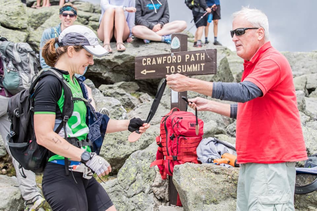 Conclusion: Carole absolutely loved this race. “The scenery of NH and the white mountains is beautiful, and there's no better moment than ascending the last bit of the summit, looking all the way back toward the valley where you started that morning. The quirks are just part of the experience--the swim buoys were still being set up 5 minutes before the start, there were no timing chips so no way to measure transition times, it took a couple weeks to get results, etc. But honestly those things were a great reminder to not take the whole thing too seriously, and to just go out and have a fun day racing.” She recommends this race for anyone who can qualify and who really likes biking on hills and hiking. She also offered to serve as training buddy, porter, or participate in a future WWMS relay team...so mark your calendars for July 25, 2020! Congratulations to Carole for being the 4th overall woman finisher! You can read Carole’s full race report here. 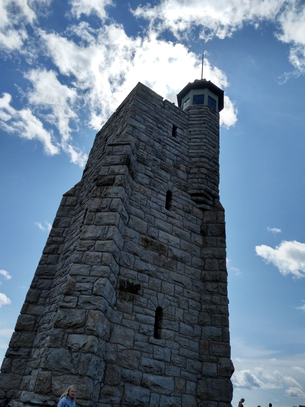 SOS (Survival of the Shawangunks) featuring teammate Jon Chesto What it is: The website describes this as an “eight stage wilderness adventure triathlon race,” but Jon paints us a much clearer and more vivid picture of his experience doing SOS New York: “We start just as the sun was starting to rise over the Hudson Valley, at an empty fairground, all 200 of us assembling in the cool morning shadows. The stone Skytop Tower looms over us in the early-morning light, off in the distance, our final destination. We all know we have 50 miles of hard biking, running and swimming to get there. The horn sounds, and we’re off, jockeying with other riders for position in our age group, while staying far enough away from each other to avoid a drafting penalty (in this race, the ref points at you and tells you to stop and unclip). We ride through a beautiful countryside: ravines, waterfalls, cliffs, sunflowers as tall as houses. The lead pack from my wave leaves me in the dust in the first major downhill. But the final climb is five miles long, uphill into the heart of the Gunks, and my lack of a tri-bike suddenly becomes an advantage, as I start passing competitors from my wave, as well as younger racers, one by one, before pulling into the first transition area. The first trail run is 4.5 miles long, but this one feels much longer. The reason? It’s almost all uphill, including a mean bastard called Cardiac whose grade reaches 20 percent in parts. Rules require us to carry everything we need for the rest of the race, so I’ve got three gels in my shorts pockets, and a swim cap and goggles in my hands, as I climb. I see no runners, though I hear one gaining on me. Better pick it up after cresting Cardiac. I worry a bit that I’m not passing anyone. Then I find out I’m in 12th as I approached the first lake, and take it as a good sign. The first swim is the toughest, 1.1 miles in frigid water (low 60s). We’re two hours in, so fatigue is already setting in a bit. I stuff my shoes into my green tri top, and hop into the water. I pass a few swimmers at the outset, but then, more loneliness. Getting back on land is hard - I foolishly take a well-meaning volunteer’s advice and sit on a bench-like rock to put on my shoes. Wrong move. The muscles along the back of my legs, hammies and calves, start to seize up at once. Painful and scary. Won’t be doing that again. The next run, 5.5 miles mostly along a ridge line, is the most scenic. You can see for what seems like hundreds of miles. I get into a groove here. It helps I have someone to run with, finally. With my legs still sore from those cramps, I decide it makes more sense to run with him than to try to pass at this point. The second lake is a half mile sprint. I think I pass two more people here but the rock-pile climb on the other side is tricky. Then it’s on to the longest run of the day, a grueling 8 mile stretch through some beautiful forestland and ledges teeming with rock climbers. The final two miles are all uphill — the infamous Godzilla Hill, far worse than Cardiac in length, if not grade. I catch up with someone who is walking for a bit. Turns out he is in fourth place. We offer each other some words of encouragement, then he hangs with me and beats me into the final lake — which, to my surprise, requires you to slide under a wooden fence to enter. 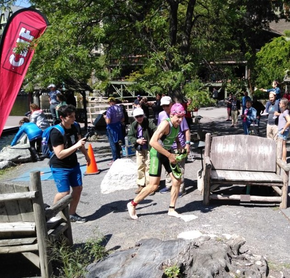 The final push is the most exciting: A swim through this glacial pool, past ancient rock formations and the majestic Mohonk House. It’s a hotel, but looks like a castle. The guy in fourth place keeps his shoes on, so I pass him with my shoeless feet and then clamber up another rock wall to get out for the final 0.7 mile climb to Skytop. (Had to cram my shoes back on, of course.) You feel like you are on top of the world when you cross that “survivor line” — it sure looks that way, too. The views are incredible. I instantly start shivering, but race CEO Evan Davis warms me up with a cup of soup. My dad surprises me by making the climb as well. Then it’s off to the massage tent to work out those cramps and reflect on five hours of joy and misery.” How was your training for this race different than training for a regular triathlon? Did you need any extra gear? Jon says he did several OWS-trail run bricks to prepare, but thinks it would have helped to have done even more. He also highlights the importance of experimenting with footwear: finding a shoe that works (he opted for quick-drying Zoots) and trying out swimming with shoes versus without (he preferred swimming without shoes to keep his kick strong). Nutrition included Clif Bloks and Skratch hydration on the bike, and gels and sports drinks through the rest of the course. 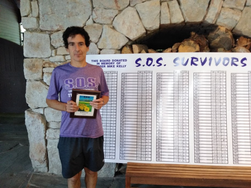 What was the most challenging part of this race? “Dealing with those muscle cramps. You expect them, but you also hope you’ve done enough training to avoid them. Those cramps after the first swim were a bit frightening, with three hours left in the race, though the pain in the back of my legs receded as quad pain took over. The eight-mile run was particularly brutal — my quads felt like they do in the final stretch of the Boston Marathon. It did not help matters that the only paved part of the run is a screaming mile-plus descent after the swim.” Sounds painful! What were the enjoyable aspects of this race? “Seeing those views from Castle Rock (the second run) is like nothing else in any other race I’ve done. I was in awe of the splendor. The swim-run combo at the end is pretty incredible too, the adrenaline really arrives here in anticipation of the finish.” Who do you think would enjoy trying this type of race? “Anyone looking for a different challenge from the typical swim-bike-run thing. Just don’t expect it to be easy. This race is the toughest triathlon I’ve ever done — much more challenging than a typical 70.3. But so rewarding, too. One of a kind. It’s two weeks since I crossed the finish line, and I’m still kind of riding on that endorphin high.” Congratulations to Jon for completing SOS Cape Cod in June and SOS New York in August, placing top 10 in both!  Spartan Obstacle Course Race featuring teammate Kristi Paradis What exactly is an “obstacle course race?” Kristi explains: “OCRs consist of upper and lower body challenges and running or hiking between obstacles. Examples of obstacles include heavy carries (sand bags, buckets) over often difficult terrain, monkey bars, rings, 6-9 foot walls, tire flips, and mud. Distances vary from 3 miles to over 26.” That seems really hard. Kristi sees it as a new way to challenge her body and mind. “This is a non Ironman year for me. I've been racing long distance triathlon for ten years now. A few years ago I burnt out of the sport and lost my love for it. I found it again, but don't want to fall out of love again. Doing a Trifecta this year is a different way to challenge and improve endurance... Additionally, my partner does OCR and this would give us a way to race together.” The positives: There are several surprising benefits that Kristi has found in doing OCRs. Learning to get over a fear of heights was one. She also says she’s “been pleasantly surprised at how much my endurance has improved with the addition of regular trail runs and high intensity full body strength workouts.” Strength training with kettlebell workouts and rock climbing were placed into regular, in-season rotation as part of Kristi’s training. Another enjoyable aspect has been making improvements in various obstacles throughout the season. As Kristi says, improvements and success can provide boosts in self esteem and push us to do more. Finally, Kristi mentions teamwork: “Like triathlon, it's been a road to meet new friends too! I've enjoyed the team aspect of the sport as well. There are many obstacles that are difficult or impossible to do without help from others. Often I have someone racing with me but there have been many times where strangers have also helped boost me over a wall...There's something very empowering about helping someone through an obstacle.”  Any extra gear? Trail running shoes, gloves, and knee and elbow pads. Conclusion: This was an enjoyable race and Kristi recommends it for anyone who is up for a new challenge! “An athlete looking for a sport that requires team building, but is also very solo may enjoy OCR!” Congratulations to Kristi for completing not one, not two, but THREE of these races for a “Trifecta” this year (a 3 mile “sprint,” a 8-9 mile “super,” and a 13.1 mile “beast”). 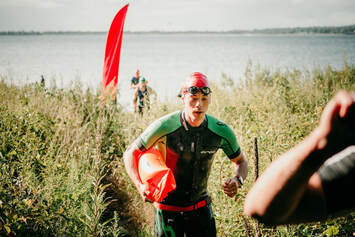 Odyssey SwimRun featuring teammates Scott Kallgren and Mark Murakami What is it? As the race name indicates, you swim, and then run...over and over and over again. The website explains it this way: "As a swimrun, The Odyssey is meant to be a different kind of multi-sport endurance competition: it challenges athletes to switch between disciplines over and over. Both running and swimming are inherently simple; body versus terrain. This event is meant to celebrate that simplicity, and give athletes a chance to test themselves against either 2 or 4 hours of this beautiful loop-style course." That’s a lot of loops! Why did you decide to sign up for this race? Mark says “The Odyssey provided a novel opportunity to push my distance limits in the swim as well as to work on cross-discipline transitions, which I need for triathlon. I also seize any chance I have to spend a summer weekend in Bristol with friends.” And, inspired by his teammate/training buddy Mark, Scott signed up too! Did you need any extra gear? The short answer: yes. The long answer:
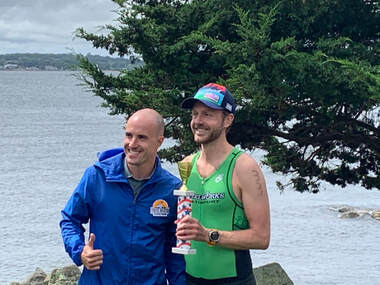 How was your training for this race different than training for a regular triathlon? Scott says he made sure to train with all the gear he would be using for the race in the Upper Mystic Lake. He notes that onlookers were confused by all this back and forth swimming and running! Mark adds that these swim-run training loops in the Mystic was useful, but that it would have helped to better approximate the race distances to complete more laps. Conclusion: Scott describes this race as “weird, but would definitely do it again!” He says that the constant cardio with recurring complete switch between upper and lower body was was really interesting, and the "only full loops count" aspect made him push really hard to finish a fifth lap in 1:59:30, just under the 2-hour mark. Mark adds: “Summer. Bristol. Start cannon (yes, a real one). Enough said.” They recommend it for anyone who likes rugged shorelines, swimming, running, and trying something different! Scott has his eye on the Boston Harbor Islands next year - anyone interested? Congratulations to Scott for 1st place overall in the 2-hour race, and congratulations to both Mark and Jon Chesto for strong finishes in the 4-hour race. Comments are closed.
|